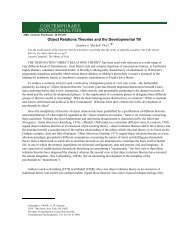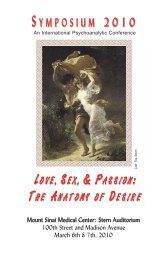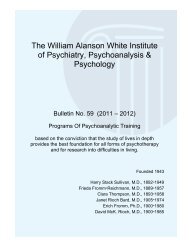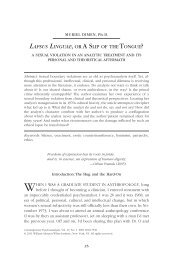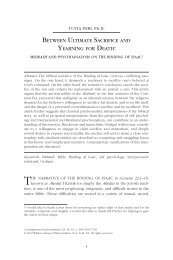FANTASY, FUSION, AND SEXUAL HOMICIDE*
FANTASY, FUSION, AND SEXUAL HOMICIDE*
FANTASY, FUSION, AND SEXUAL HOMICIDE*
Create successful ePaper yourself
Turn your PDF publications into a flip-book with our unique Google optimized e-Paper software.
495ABBY STEIN, Ph.D.<strong>FANTASY</strong>, <strong>FUSION</strong>, <strong>AND</strong> <strong>SEXUAL</strong> <strong>HOMICIDE*</strong>Abstract: This paper presents an analysis of the confessions of two men whokidnapped, raped, killed, and mutilated a young woman (though not necessarilyin that order). Following their initial denials of involvement, both men providedlengthy iterations of the crime, although, as you will see, their recollections ofwhat occurred—or at least their recounting of events for the police—differ somewhatdramatically from one another. In addition to mining these narratives forclues about the dissociative structure of perpetrators’ interiority and actions, Ihave attempted to find within the stories information relevant to the most widelydisseminated theory in the forensic and criminological literature as regards theantecedents of sexual homicide, namely that it is the overreliance on sexualized,aggressive fantasies that undergirds these fatal interactions (Burgess et al., 1986;Ressler, Burgess & Douglas, 1992; Prentky et al., 1989; Meloy, 2000; Schlesinger,2000). While so many in the forensic field have concentrated on the criminogenicpower of the paraphillic fantasy to transform dreamers into deviant actors, thisanalysis suggests that it is the formative power of deviantized, preoedipal objectrelations, and the ensuing reliance on dissociative defenses (including quasidelusionalfantasies), that determines who crosses the line from fantasy into action.Keywords: aggression, violence, murder, homicide, rape, fantasy, dissociationILIVE in a room filled with violent narratives. Law enforcement shipsus cases; we analyze them. The literature that informs the analyses ismost often concerned with patterns and motives, modus operandi andcriminal signatures, the organization or disorganization of crime scenesand those who create them. The analyses work toward the identificationof variables that can inform a predictive model of violent perpetration(fire-setting plus enuresis plus cruelty toward animals equals ...),orthatwill at least tell you the best places to look for suspects (Veteran’s hospi-* The names of the perpetrators and the victim, as well as other identifying informationdeemed insignificant to the analysis of this case, have been changed in order to protectthe anonymity of the subjects.0010-7530/04 $2.00 + .05Copyright © 2004 W. A. W. Institute20 W. 74th Street, New York, NY 10023All rights of reproduction in any form reserved.Contemporary Psychoanalysis, Vol. 40, No. 4 (October 2004)
496 ABBY STEIN, Ph.D.tal? Post office? Their mothers’ houses?) once the victims’ bodies arebagged.I don’t know the victims personally, although I am intimate with theligature scars that circle their necks, the precise way their nipples wereexcised, and the exact amount of blood that soaked the carpet wherethey were stabbed. I don’t personally know these perpetrators whoseeyes watch from colorless mug shots, although I’ve talked to scores ofothers. I know them only through the gruesome photos of their handiworkand the spontaneous or elicited confessions they offer to lawenforcementofficers and court-appointed psychiatrists.The murderers’ disembodied words testify to the vitality of their fantasiesand the clumsiness of their cognitions, their presyntaxic modus operandi,their massive mismanagement of accounts and accountability.These words, and what is captured by the coroner’s camera and themedical examiner’s report, are as close to an accurate history as I’ll get.It is my conduit to the fixing of events in time, and my way of inferringmeaning and agency from perpetrators whose own “capacity for historicity”(Grand, 2000, p. 18) may have been functionally erased.Much of the forensic literature has concentrated on the paraphillic fantasyas a dry run for solitary rape-murder and serial sexual homicide(Burgess et al., 1986; Ressler, Burgess & Douglas, 1992; Prentky et al.,1989; Meloy, 2000; Schlesinger, 2000). Despite an overwhelming agreementamong these authors that a preoccupation with sadistic or controllingsexual fantasies potentiates murder, only a few forensic clinicians(Lewis, 1998; Carlisle, 2000; Meloy, 1997) have written about these ultimatelyrealized fantasies as having been nurtured in the cradle of dissociatedtrauma. Meanwhile, the psychoanalytic literature has theoreticallydemonstrated a compelling link between dissociated trauma and someforms of sexual perpetration (Grand, 2000).Former FBI profiler Robert Ressler and his colleagues (1992), largelyresponsible for the theoretical views that prevail in the forensic literature,strongly reject the idea that sexual violence is primarily rooted in childhoodtrauma, but rather believe that it stems from an overreliance onsexual and aggressive fantasies developed in response to various threats,only some of which may involve child maltreatment. The fantasies supposedlyconstitute a cognitive rehearsal for sexual murder, but, the theorygoes, because repetition erodes the fantasies’ masturbatory powerover time, the individual begins to seek out opportunities to act uponthem. Sexual homicide, thus conceived, is an event largely driven by
498 ABBY STEIN, Ph.D.acts with lustful feelings. Thus arises a powerful impulse to commit theimagined deeds. [p. 57]Contrast all of this with the view that murder is not an event, but astep in a very long, sometimes covert, internal process, which begins inchildhood and continues even after the homicide is committed (Gilligan,1996, p. 125). The latter position acknowledges the resonant power ofdistal events, both in shaping proximate intrapsychic content and indrafting particular fantasized elaborations into active defensive servicewhen other contextual cues for criminality are present. Inasmuch as fantasiesof sexual control and surrender through physical force are incrediblycommon in the general, nonoffending population (Leitenberg & Henning,1995), and because sexual offenders fantasize about and engage inconsensual sex at least as often as they seek out coercive sexual encounters(Marshall & Marshall, 2000), it seems equally if not more importantto focus on factors that may blur the fantasy-reality line for certain individuals,as to deconstruct the fantasies themselves.I have written before about the dissociative context in which manyviolent enactments occur (Stein, 2000, 2001, 2003). I have joined suchwriters as Grand (2000), Lewis and her colleagues (1991, 1997), Meloy(1988), and Steinberg and Schnall (2000) in the opinion that dissociationis the default defensive position of the perpetrator, its probable genesisthe realization and subsequent elaboration of annihilative-reconstructivefantasies during terrifying scenes of actual abuse and neglect in childhood(Stein, 2001, 2003). I have had trouble, however, in conjuring criminogenictraumata as going from wholly submerged, to fully realized andprojected, to totally resubmerged, as the violence of dissociative offendersis sometimes characterized (Saks, 1997). Rather, my analyses of thenarratives of violent criminals have underscored the delicate way in whichconscious and unconscious forces parry each other for dominance inpre-, peri- and postcrime mentation. Thus, I remain attuned to the consciouscomponent(s) of criminal thought and activity, and perceptive tothe faint outlines of volatile selves that lurk in the corners of consciousawareness (Lifton, 1986; Rank, 1971).Traditionally, forensic clinicians and criminal profilers have borrowedthe paradigms of cognitive-behavioral psychology, working from a set ofassumptions that see human behavior as largely conscious and rational,and fantasy materials as goal-oriented, hedonic visualizations. Psychoanalystshave concentrated on unconscious motivations for behavior and
<strong>FANTASY</strong>, <strong>FUSION</strong>, <strong>AND</strong> <strong>SEXUAL</strong> HOMICIDE499the more symbolic modes through which needs and desires may be expressed,including in the creation and distribution of imagery in daydreams,night dreams, delusions, and ruminations, as well as more specificallysexual fantasies.In understanding the role of fantasy in acts of criminal violence, it ismy hope to demonstrate the utility of shouting politely across the theoreticaldivide. Unconsciousness is a leaky boat on the waters of consciousness;nowhere is the concept of “know(ing) more than one thinkshe knows” (Ogden, 1989, p. 197, italics mine) more pertinent than in theanalysis of human predation. Conversely, it is particularly important forthe individual perversely conjoined with a sexual object to maintain astate of dumbness because, to paraphrase Stoller (1985, p. 34), “Insightis the death of (sexual) excitement.” The insight to which Stoller refers isthe knowledge that the actual aim of what he calls “erotic hostility” is toundo humiliating, painful childhood traumas that threatened the developmentof core identity (1985, 1986). The perverse sexual fantasies andperformances that develop in response to the annihilating behavior ofearly caretakers are as much a barricade against anxiety and ego dissolution(Socarides, 1973) as they are a behavioral response to the stimulatingaspects of mental and physical pain (Freud, 1919). The incipient fantasies,and their adult corollaries, are as much symbiotic as they are sexual.Violent sexual daydreams embrace without intimacy, risk engulfment (thissupplies the excitement), evoke terror, and justify retaliatory violence.Given the nuclear power of the experiences from which such fevereddreams are derived, is it any wonder that some people cannot resist thetemptation to symbolically revisit the scene of the original crime?How sexual murderers use their fantasies, and how the fantasies usethem, is the subject of this analysis.The Murder of Kim Standard[We] brutalized, traumatized, raped, and strangled her with a piece of rope.[She] was convulsing and losing her bladder, then [we] disposed of her likeso much garbage in a lake.(From the confession of Alan Plethory)I was invited to a friend’s house. He pulled a knife on a gal. At that pointeverything went downhill. We ended up killing her. Why, I wish I knew,but we did, and I cannot change that.(From the confession of Dave Justus)
500 ABBY STEIN, Ph.D.Alan Plethory was an acquaintance of the victim, Kim Standard, thatday they met in a bar where he made occasional repairs. He offeredStandard a ride and the two, according to Plethory, proceeded to thehouse he shared with his wife, who was at work. Once home, he calledhis close buddy, Dave Justus, asking that he come over with a six-packof beer. (The two men had met in prison, where they were both servingtime for sexual offenses. Later in their relationship, Dave had sex withAlan’s wife, in her husband’s presence.) The three drank for a considerabletime and chatted amiably; Alan insists they spoke about group sex.At some point, Alan became concerned that his wife would return fromwork and not take kindly to an alien female presence in her house. Dave,too, was becoming anxious: he was scheduled to retrieve his child fromday care.Plethory later said that they decided to kidnap the girl because sherefused to have sex with them. The men subdued Standard, undressedher, tied her hands and feet with rope and duct-taped her mouth, thenput her in the trunk of Justus’s car and drove off. When she managed tountie her hands and pop the trunk they restrained her and drove insteadto an isolated area. Plethory said he then watched Justus rape and strangleStandard, but denied his own participation, other than in dumpingthe body. Justus initially denied, but later admitted, the rape-murder, sayingthat together he and Plethory had strangled Kim with a rope anddisposed of the body.The young, divorced mother’s decomposed body was found in anearby lake, a circle of plasticized duct tape around her neck. Therewere wounds to Kim’s hands and one breast, sharp perforations of herpelvis; her abdomen had been eviscerated. Blunt force injuries ringedthe upper body; her tongue had been severely lacerated. Kim Standardhad been horrifically sexually violated, although neither assailant hadpenetrated her vaginally with their penises.Were the men compulsively reenacting a traumatic sexual engagementfrom their own pasts? Little is known about Alan’s childhood, but interviewswith Dave’s friends and family supply some provocative material.Justus’s mother once told a friend that Dave always “licked the plateclean,” a reference to his preference for cunnilingus, not his childhoodeating habits. Justus’s father sometimes tried to have sex with his son’sfriend’s girlfriends, the house was filled with pornography, the parentssexually inappropriate in front of the children, and Dave was apparentlyintroduced to sexual bondage techniques by his older brother. He wrote
<strong>FANTASY</strong>, <strong>FUSION</strong>, <strong>AND</strong> <strong>SEXUAL</strong> HOMICIDE501and shared his sexual fantasies—including having sex with a girl whohad not yet developed pubic hair—with a married woman with whomhe had an affair after his wife left him. His wife said that he liked roughsex, once putting a large knife to her throat during foreplay. Other sexualpartners found him excessively brutal and disgustingly unclean. He tooknude pictures of many of the women with whom he had consensual sex.Lear (2000, p. 89) suggests that rather than seeing these repetitive engagementsas driven (in the Freudian sense), they should be seen as“dramatic instances of mental self-disruption that are met with a repetitivelyfailed attempt to lend meaning” to an event. Thus, violent sexualitymay not only be an attempt to extinguish, or master, a timelessly recurringtrauma (Shengold, 1999; Herman, 1992), but also an attempt to findthe logic of one’s own catabolism through the destruction of others. Wedon’t know if Justus and Plethory were sexually assaulted in childhood,but we can surmise that, at least in Justus’s case, the sexual atmospherein the home was deviant and, on some level, threatening to a youngchild, who likely responded by selectively attending to such overwhelmingand invasive sexual stimuli.The killers were apprehended attempting to flee the country. Duringinterrogation, Alan offered scant information, most of it denying, or justifying,aspects of the crime. Dave, clearly shaken, provided a more detailedaccount of what happened that day. Yet both men’s narration ofevents are retrieved from a place so stark and dreamlike the stories seem,at times, more fanciful than real. In particular, the dissociated quality ofDave Justus’s interaction with his victim appears stunning in its claustrophobicsymbiosis. Where Alan projects, Dave adheres. Where Alan mentallyflees, Dave virtually disappears.The Justus-Plethory NarrativesHe and Kim were just talking when, Justus says, Alan Plethoryemerged from the kitchen holding a butcher knife with a foot-long blade.He put the knife to Kim’s throat and said, “This is a rape.” According toJustus, she laughed and pushed Alan’s hand away. Although there wasno audible communication between the men, Justus says that he sensedthat something was about to happen. Simply, somehow, Justus “found”himself undressing her. “She lifted up to help me take her pants off. Shegot down on the floor and said ‘if you’re going to rape me, let’s go outto the woods,’ because she likes it there. Alan tossed me the rope and
502 ABBY STEIN, Ph.D.some duct tape. She let me tie her hands, but said that the rope aroundher ankles hurt, so I brought her some socks to put on.” She was hogtiedand put in the trunk of the car. “I said, ‘Now what?’ and Alan said‘Let’s take her to your place.’”AdhesionJustus’s communication is quite magical: his fancied communion withthe victim and his wordless implementation of Plethory’s wishes is remarkablyseamless for what was, in essence, a very sloppily executedcrime. In his story, the victim laughs (“Yes, I found that puzzling. Weboth did.”) and even dictates the location where she will be violated. Sheassists in the stripping of her clothes, and only tangentially objects to theroughness of the rope tying her ankles, whereupon Justus immediatelycushions her feet. All agency seemingly redounds to the acquiescingStandard and the knife-wielding Plethory who, in concert, create the parametersfor the rape. Justus “only” binds the victim, but is himself unbounded,already affectively leaking and leeching. It is as if Justus seeshimself and Standard as working toward similar ends: she is picturedover and over as a cooperating—even giddy—partner in the assault.Justus, in the protective act of bringing her socks, engages in a magicalreparation: untying and psychologically undoing. The retying now softenedso that it is no longer experienced as an authentic binding, thesadistic act is experienced as not really real (Grand, 2000). In this, Justusrewrites himself as a helper rather than a perpetrator.The selective attention that served him in childhood is in abundantsupply here. By not owning aspects of his own behavior (he simply findshimself in an abduction scene, directed by his friend), and by disavowingthe victim’s fear (she laughs at butcher knives, she prefers to be raped inthe woods), he spins a tale where the victim has no claim to innocence,while he is already not guilty of a crime he has yet to commit.Because, in this kind of adhesive state (Ogden, 1989; Mitrani, 1994),there is no sense of self as distinct from other, one cannot be the knowingagent of either active perpetration or active resistance. Instead, thereis an imagined intimacy with the victim, Justus anticipating her comfortneeds as Kim has anticipated his need to remove her garments. But thegratification of closeness will ultimately turn to the terror of engulfment(Socarides, 1973) that activates the murder. Whereas perceived separatenessand felt agency might precipitate a view of one’s objects as three-
<strong>FANTASY</strong>, <strong>FUSION</strong>, <strong>AND</strong> <strong>SEXUAL</strong> HOMICIDE503dimensional and capable of being hurt (Ogden, 1989), here there is onlya delusional transference that magnifies annihilation anxiety, and a reactiveomnipotence that exacerbates sadistic retaliation (Meloy, 1997).Such pseudoidentifications as appear here between Justus and Standardreflect the need to devour and incorporate—a fanatasized symbioticfusion most likely constructed in the absence of a need-gratifying objectduring the earliest stages of separation-individuation (Mahler, 1968;Socarides, 1973; Meltzer, 1975; Mitrani, 1994; Meloy, 1997). As the mostautistic-symbiotic aspects of the fantasy unfold in horrifying detail duringthe actual rape-murder-mutilation, Justus will be confronted with the terrifying,destructive magic of his own fantasies.Justus is simultaneously engaged in an analogous identificatory processwith his co-perpetrator. The communication between Plethory andJustus is wordless and seamless, and one senses that there are not evenillusory boundaries between them. Justus’s experience of Plethory’s directivesto truss and gag the victim unspool almost telepathically in thisimprovised—and impoverished—pathodrama. An autistic interface is effected,where objects are related to one another through what Ogden(1989) calls “rhythmicity and sequencing,” where experiences of “me-notme” and “inside-outside” don’t exist.Plethory is inside of Justus, dictating his actions, while Justus is alsoan appendage of Plethory, making the necessary arrangements for Standard’srape-murder. Although not tacitly acknowledged, the homosexualovertones of their relationship (it appears that much of their sex livesinvolved sharing fantasies and then finding women who would agree tohave sex with the two of them simultaneously) suggest an impairmentin the development of masculine identification (Stoller, 1986), perhapsharkening back to an unsuccessful separation from the mother that islater compounded by castration anxiety during the oedipal phase (Socarides,1973). If the inappropriate sexuality of the parents documented inJustus’s life history is true, it is easy to understand the parental threatposed to the subject throughout his development.Justus’s adhesive orientation, coupled with his questionable genderidentification, makes him especially vulnerable to seeking resonancewith powerful male objects like Plethory. In the dynamic of sexual aggression,Justus follows Plethory’s initiatives. As Meltzer (1975, p. 297)has said in explicating Bick’s autistic patients, this type of person baseshis morality not on introjected objects that are precursors to superego,but on the imitation of others. It is not an uncommon trait in certain
504 ABBY STEIN, Ph.D.criminals to transmute in this way, to easily take on the form of the other.Such simulative ease points to a kind of “dissociative flexibility” (Meloy,1997, p. 143) and finds its most toxic home in the goodness of fit betweentwo potentially violent psychopaths.ProjectionUnlike Dave’s portrait of a submissive, even willing victim, Alan remembersKim Standard as being boisterous and belligerent in the livingroom, obnoxious and excessively noisy: “I started getting paranoid becauseshe was loud. She started saying that she was gonna yell rape. Noone had touched her. We were seated fully clothed. We told her we weregonna tie her up and cover her face and she started to shut up a littlemore.” Was there a conversation between he and Dave? “It was morethan just a look ’cause we both ...because of our backgrounds, thethreat of someone crying rape ...is pretty hard on a guy.” She wasbound. Gagged. They put her in the trunk, although she very nearlyescaped. They drove to an out-of-the-way park.Plethory seems to have had a much more conscious antagonism towardthe victim than did Justus: she posed a real peril as well as a fanciful,projected one. I imagine that her initial response to Plethory’s rapewarning (if, indeed, she did “laugh”) was excruciatingly dismissive, anddiminishing. Standard must have seemed a potent, castrating witch withthe power to send Alan back to jail, a threat to be neutralized at any cost.The terror of returning to jail cannot be underestimated, given the almostdaily diet of assaults, rapes, robberies, and more symbolic castrations(Gilligan, 1996) to which inmates are subjected. In response, Plethoryproceeds to make Standard into “a controllable puppet” (Searles, 1960,p. 278), a hogtied symbol of all of the dangerously unpredictable earlierobjects he feared would dismember or dismantle him, and a stand-in fora previous victim whose testimony had sent Plethory to prison.Perverse people deal with their partners as if the others were not real peoplebut rather puppets to be manipulated on the stage where the perversionis played. In the perverse act, one endlessly relives the traumatic orfrustrating situation that started the process, but now the outcome is marvelous,not awful, for not only does one escape the threat, but finally immensesensual gratification is attached to the consummation. The wholestory, precisely constructed by each person to fit exactly his own painful
<strong>FANTASY</strong>, <strong>FUSION</strong>, <strong>AND</strong> <strong>SEXUAL</strong> HOMICIDE505experiences, lies hidden but available for study in the sexual fantasy of theperversion. [Stoller, 1976, p. 105]FusionAccording to Justus, she emerged from the car trunk asking for beerand a cigarette. She wanted to know what was going to happen. Alantied her up again and put her back in the trunk and continued driving.The two men never spoke of what they were doing. When they arrivedat the new location, they removed Standard from the car and carried herto a more densely wooded area. Dave said that Kim requested somethingto lie on. He says that she then asked to be held: “I sat down next to herand she put her head on my shoulder. Alan went and got a floor matfrom the car. Someone said ‘Now what?’” At this point, Dave says thatAlan tried to penetrate the victim with his fist. “And I tried, too, becauseAlan wanted me to. She never said anything or cried.” Then Alan foundan old can, which he partially inserted into Kim’s vagina. Justus foundthis strange and instead flipped her over and tried, unsuccessfully, tocommit anal rape. When the investigator expressed surprise that the victimnever screamed, whimpered, or cried during what must have been avery painful sexual assault, Dave ventured, amazingly, that “maybe she’ddone it before.”The comment that “maybe she’d done it before” (referring to the vaginalpenetration by fist and inanimate object, and the anal rape) is one ofthe more stunning pieces of criminal commentary I have come across.(It is reminiscent of the time a middle-aged man described to me howhis four-year-old stepdaughter had seduced him.) Clearly, on a cognitivelevel, the words dovetail with observations that rapists tend to view theirvictims as sexually experienced and willing, sometimes even aggressivelyprovocative (Marshall & Marshall, 2000). But I find both the violative actsand the narration that selectively attends them suggestive of a level offantasy more symbiotic than sexual.It is a not uncommon feature of serial rape and sexual homicide toforce large objects, including inanimate ones, into the victim’s vagina.This activity has mostly been examined for its sadistic dimensions relativeto a variety of behaviors coded on a “torture” axis in the criminal-profilingliterature (Dietz, Hazelwood & Werren; 1990; Stone, 1998). Few havenoted the almost childlike—even innocent—fascination with the proportionsof the womb that is reflected in these acts, although Meloy (2000,
506 ABBY STEIN, Ph.D.p. 2) does refer to the “curiosity” that often symbolically infuses certainaspects of sexual crimes, particularly genital mutilation (also a componentof the Standard murder).Plethory especially is concerned with how much, how many objectsare needed to fill up a female container (his prior conviction was forraping a waitress with a bottle). In addition to the almost certain senseone gets that Plethory and Justus didn’t imagine their own penises to besufficient for the task of filling a female (neither attempted penile penetrationof Standard’s vagina), the act seems a perverse attempt to createa missing birth tale.The perpetrator’s obsession with filling the womb is somehow synonymouswith crawling back inside it, and enacts a fantasy of symbioticfusion. In this context, it is no accident that perpetrators most often attemptto fill the victim with varied detritus, having the vagina and uterusdouble as a garbage can. For the perpetrator it’s a redux of the old adage:garbage in, garbage out.Theoretically, a “good” mother gifts the birth narrative to her child,satiating his phenomenal hunger with a monotonous retelling of how hegot here (only she witnessed the birth, after all—he has no recoverablememory of it). In doing so, she confirms the child’s existence as well asher pleasure in it. A bad or absent mother never validates the child’saliveness in any meaningful way. Through traumatic imposition, theabusing or abandoning mother may actually assist in the perceived undoingof birth. Searles’s (1960) proposed stages of ego development haverelevance to Plethory’s inanimate extension of himself with the foragedcan:(1) experiencing oneself as being alive, and therefore distinct from theinanimate things in the environment; (2) awareness of oneself as not onlyalive but human, and therefore distinct from the animate sector of thenon-human environment (i.e., animals and plants); and (3) awareness ofoneself as a living human individual, distinct from other human beings,including one’s mother. [1960, pp. 43–44]Plethory and Justus must get back inside to stem the tide of existentialpanic. But then they must pay the “consequences of retreating inside thematernal body” (Socarides, 1975, p. 434): the dreaded, irreversible loss ofself. In this claustrophobic moment, only the destruction of the maternalsymbol can reinstate separateness and restore homeostasis.
<strong>FANTASY</strong>, <strong>FUSION</strong>, <strong>AND</strong> <strong>SEXUAL</strong> HOMICIDE507DissociationMaybe she’d done it before. Of course, it was Dave Justus and AlanPlethory who had “done it before.” Alan, as noted, had already servedtime for a bizarre, brutal rape. Dave had abducted and sexually assaultedan adolescent girl at gunpoint with his friends. His wife had left him aftercharging that he had sexually abused their infant child.Alan says that he walked back to the car to get the mat because hethought that Dave was “going to have sex with her and I didn’t want tobe there.” He “stared off into space” but at some point turned and sawDave Justus having sex with Kim, with her on her belly. “I continuedspacing out.” When Alan eventually returned to the scene, both physicallyand mentally, Dave was kneeling beside the victim. She appeareddead. “I don’t want to say [what I saw].” He helped carry the body backto the car. “I did not see one drop of blood anywhere. I didn’t. I swear Ido not see blood.”In Dave Justus’s version of events, when the rape ended, it was Alanwho picked up her head and put a rope around her neck. He handedone end to Dave and they both pulled. No words were exchanged.“She didn’t make a noise. She didn’t move.”“How long did you do it?”“I didn’t know. Time just seemed to take forever.” She didn’t struggle.She convulsed.“Everything seemed to take forever and then, too, it didn’t take verylong either. She convulsed and lost control of her bladder.” Dave triedto find the pulse on her neck, and then Alan untied her hands. Theydrove to a convenience store, to purchase soda and candy, with KimStandard’s body in the trunk. Dave called his wife to say that he wouldn’tbe able to pick up their child from daycare, after all.AfterwardsJustus and Plethory headed out to a river to dispose of the body, butthe car got stuck within sight of the shoreline and Justus went to gethelp. He walked to town—a considerable distance—and flagged downa police officer, who helped him to make assistance calls.It is not uncommon for criminals to tempt capture in this way. Is this aguilty conscience lacing its own trap (Freud, 1916)? or merely diagnosticevidence of a grand and brazen psychopathy (Millon, Simonsen, Birket-
508 ABBY STEIN, Ph.D.Smith & Davis, 1998) that convinces its host of his own invulnerability?Is it, perhaps, that Justus can ask an officer for help—unencumbered byany real fear of arrest—because the memory of the murder has beensuccessfully converted to a kind of unreality, a conscious unconsciousnessthat many violent offenders articulate as “waking dreams” (Stein,2003).“I kept walking, kept expecting her to walk out on the pavement anytime.Kind of stupid, huh?” The investigator asked if Justus thought thatStandard was going to come after him. He admits, “I wouldn’t blame her.”When Dave returned to the beach, Alan Plethory had already disposedof the body. Most of the victim’s personal things were discarded, althoughJustus retained Kim’s running shoes, as well as a soiled piece ofher clothing, perhaps a memento to aid him in reliving the crime, perhapsa trophy to signify his triumph over this threatening object.Although her pelvic and abdominal region had been gutted, both mendenied knowing the origin of Standard’s wounds. Justus conjectured thatPlethory had mutilated the body in the hours when Justus had soughthelp for their disabled automobile. Plethory claimed not to have seenany wounds. “I don’t know of any damage. It frightens me ’cause I don’t.I don’t remember anything like that. I don’t want to picture it. I do notremember seeing a single drop of blood anywhere. It’s scary to think. I...Ican’t picture Dave doing anything ...Idon’t want ...”(Atthis pointthe investigator reminds Alan of the other horrible things he has seenDave Justus do.) “Everything I saw ...I told you ...I swear I did notsee any blood. I know I did not see any blood.”Plethory and Justus have each accused the other of the pelvic eviscerationof Kim Standard, and the forensic evidence cannot decisively assignblame. Interestingly, it is in discussions of mutilation that criminal profilersdo accept the gravity of sexual trauma histories, finding that “undisclosedand unresolved early sexual abuse may be a contributing factorin the stimulation of bizarre, sexual, sadistic behavior characterized ina subclassification of mutilators” (Ressler, Burgess, Hartman, Douglas &McCormack, 1986).Indeed. The ritual components of a sexual mutilation conceivably constitutea scream for purification in the face of one’s own perceived defilementat the hands of early caretakers.[the] exemption from defilement is not produced in any total and directaction, it is always signified in partial, substitutive, and abbreviated signs:
<strong>FANTASY</strong>, <strong>FUSION</strong>, <strong>AND</strong> <strong>SEXUAL</strong> HOMICIDE509burning, removing, spitting out, covering up, burying. Each of these actsmarks out a ceremonial space, within which none of them exhausts itssignificance in an immediate and, so to speak, literal usefulness. They areacts which stand for a total action addressed to a person taken as an undividedwhole. Hence, defilement, insofar as it is the “object” of ritual suppression,is itself a symbol of evil. [Ricoeur, 1967, p. 35]DiscussionThe fantasies of the perpetrators in this paper have been inferredthrough an analysis of their words and deeds. I remind the reader that Ihave never met Plethory and Justus. Of course, even in cases where adirect assessment of subjects’ fantasies can be made, there is little guaranteeof the veracity of the information given. The reports of deviant fantasiesgiven by offenders following arrest are particularly questionable,given the secondary gain to be realized by defendants whose accountsappear bizarre, disorganized, or psychotic.Often forensic clinicians are left to draw conclusions about the use offantasy from projective tools like the Rorschach, or must rely on penileplethysmograph data to ascertain the connection between thought andarousal in perpetrators (Meloy, 2000). But even if we find that sexualoffenders are aroused by so-called deviant material, or resort to it withgreater frequency than do “normals” (neither of which has been evenclose to conclusively documented), that still tells us little about why certainmen or women—unlike others with similar fantasies—end up actingout the most violent and perverse aspects of their inner dramas.Most motivational models of violent sexual perpetration have positedthat a number of conditions tend to adhere for active offenders. Theseinclude poor social circumstances, psychopathic personality, autonomicdysregulation, cognitive dysfunction, a history of abuse, and deviantarousal patterns. Of these, particular emphasis has been placed on therole of paraphillic fantasy, consciously modeled, as a cognitive rehearsalfor violent sexual crime. Here is what the most eminent of criminologicaltheorists say:Whereas psychological motives for violent behavior are usually conceptualizedin the literature as having roots beginning with trauma, insult, and/or overstimulation in early childhood, our thesis is different. We hypothesizethat these men are motivated to murder by their way of thinking.
510 ABBY STEIN, Ph.D.Murderers are consciously aware of the central role of fantasy in theirlives and their preference for fantasy over reality. ...Such thinking becomesan important component in the maintenance of sexually aggressiveviolent behavior. [Burgess et al., 1986, pp. 257–258]Indeed, over the years, a virtual cottage industry has arisen amongcognitive behaviorists who treat the fantasies of deviants as the independentvariable in the equation, attempting through aversive techniques tochange the fantasies, and hence, the dependent variable of behavior.The long-term effectiveness of these interventions has not been clearlydemonstrated (Leitenberg & Henning, 1995).Psychoanalysts, on the other hand, have most often treated paraphillicfantasy as an effect, rather than a cause, of conduct. Some, however,have taken an intermediate position, seeing fantasy as both a derivativeand a determinant of behavior (for a review of both the behavioral andpsychoanalytic literature, see Abel & Blanchard, 1974). This latter positionseems the most fruitful avenue of discovery on the subject.Robert Stoller (1985, 1986), a prolific writer on the topic, believes thatthe wish to harm may be the organizing factor for all sexual excitement.the details of the script underlying [sexual] excitement are meant to reproduceand repair the precise traumas and frustrations—debasements—ofchildhood; and so we can expect to find hidden in the script the historyof the person’s psychic life. [1986, p. 13]The hostility in perversion takes form in a fantasy of revenge hidden inthe actions that make up the perversion and serves to convert childhoodtrauma to adult triumph. [1985, p. 8]Expanding the Freudian perspective, which dictates that all peoplehave suffered and repressed trauma (and thus possess the raw materialfor perversion), Stoller hypothesizes that the character of paraphillic fantasystems, “not from some generalized state of Oedipal alarm,” but fromthe fact that “in childhood, one was truly threatened with a danger toone’s sexuality .... This trauma was very severe ...it was prolongedtoo far, or else hit too suddenly, or when one was too young for adequatedefense (Stoller, 1976, pp. 118–119, italics mine).Not all traumas are created equal. Preoedipal annihilation fears thatare realized rather than simply imagined, because the caregiver brutallyabuses or chronically neglects, form the basis for a dissociative adapta-
<strong>FANTASY</strong>, <strong>FUSION</strong>, <strong>AND</strong> <strong>SEXUAL</strong> HOMICIDE511tion that exponentially magnifies the destructive power of ensuing elaborations.Stoller believes, as do I, that it is in the very potency (and earlytiming) of the experience igniting the perverse and vengeful fantasy thatthe propensity for violent enactment can be found.A very high percentage of violent offenders have horrific histories ofmaltreatment at caretakers’ hands, and there is clinical evidence suggestingthat much of this early trauma has been dissociated (Stein, 2001,2003; Lewis, 1991, 1997, 1998; Saks, 1997). The manner in which early,prelinguistic experiences of defilement become embellished and internalizedshould be of great interest to forensic clinicians, precisely becausethe experiences so often find their ultimate representation in thegraphic “reproduction of evil,” to borrow an evocative phrase from analystSue Grand (2000).In my work with offenders of all stripes, I have found this to be largelytrue—that violent thoughts and deeds are primarily a reparative responseto the enduring trauma of perceived annihilation in early childhood,whether trauma took predominantly sexual or physical forms (Stein,2001, 2003). Often, even the purely physical violence that gets expressedin crimes has symbolic sexual components (see Schlesinger & Revitch,1997 for a review of findings in this area), just as a good deal of sexualperpetration conveys conflicts not directly sexual. As J. L. Silverstein(1994) has observed, the aggressive daydream is essentially a way ofreasserting one’s power in relationship to exceptionally oppressive, orsadistic, parents. Sexually aggressive fantasies especially, because theysignify union, express both the terror of separation from, and the terrorof engulfment by, early objects who have set up a suffocating entanglementwith the child. The more legitimately terrifying the actual interactionswere on which the fantasies are based, the greater the likelihoodthat a terror-inspiring resolution will be attempted. The abduction andrape of Kim Standard demonstrated the perpetrators’ need for symbioticfusion. Her murder and mutilation communicated the need to sever thosesame haunting ties.ConclusionAs spotted with dissociative amnesia as their accounts are, Plethoryand Justus’s crime is not easily reconstructed. But the dissociative structureof their narratives is revealing. The narratives suggest that, in elaboratingthe stimulation of initially dissociated traumata, a powerless child
<strong>FANTASY</strong>, <strong>FUSION</strong>, <strong>AND</strong> <strong>SEXUAL</strong> HOMICIDE513When we see a person moving through life with a striking type of selectiveinattention, like the boy who everyday had sadistic fantasies ...we arejustified in assuming something like this: that if we had a full record of thisboy’s sadistic fantasies, day by day, we would see in this record certaincontinued stories, certain elaborations, and so on, which would literallyrepresent a development of the skill, detail and refinement of his sadisticfantasies. There would be a growth in refinement and increased specificityof the impulse to injure innocent bystanders .... So we have to assumethat such things as dissociation—which go on quite suavely, but entirelyexterior to the personal awareness of the creature that is showing them—also become elaborated and refined. Thus what may start out as a ratherclumsy dissociated activity may finally become a performance which isstrikingly and exquisitely refined—in the sense of showing a vast amountof experience—even though the person is blissfully unaware of it. [pp. 69–70]The criminal profilers are largely correct about the uses of fantasy,although they may be italicizing the wrong words. It isn’t the overrelianceon deviant fantasies, but the overreliance on deviant fantasies thatshould sound the first warning bell, because it signals an inability tonegotiate lived experiences of closeness and threat. Second, rather thanviewing the fantasies themselves as totally volitional visualizations, Iwould recognize that imaginative material also occurs as borderline delusionalphenomena that mix—not only sex and aggression—but shameand grandiosity, violent separation and symbiotic fusion. Third, and mostimportantly, such dependency on dissociative reverie can usually betraced back to startling, perverse traumata that become elaborated andreenacted in the service of saving one soul, dreadfully and irrevocably,at the price of another.Analysts are beginning to understand just how often the story of themaltreated child is the story of the violent perpetrator is the story of themaltreated child. ...Around it goes, as attested to in both the empiricaland clinical literature (Widom, 1989; Lewis, 1992, 1998; Lewis et al., 1997;Grand, 2000). It is thus imperative that those who work with the veryviolent acquaint themselves with the psychoanalytic understanding ofmalignant dissociation, characterized by Grand as the process that enablesthose victims of massive trauma to metaphorically transcend theloneliness of annihilation by inflicting it on another person.Dissociated traumatic experiences fuel the repetitive fantasies of union(both consensual and not) that cohere the internal world of the victim-
514 ABBY STEIN, Ph.D.perpetrator. The elaboration of these asyntaxic events lend shape andmeaning to personal narratives, and trigger a variety of enactments, onlya very few of which are criminal. Depression, suicidality, compulsivesexuality, pathological lying—even serial monogamy—can be understood,depending on the patient, as autonarrative extensions of a traumaticmanuscript. Often, it is the intractability of these kinds of enactmentsthat most frustrates analysts, precisely because the early experienceson which they are based seem so split off and inaccessible. According toBromberg (1998), it may be that “trauma and dissociation breed in everyhuman being discontinuous realities that are not amenable to interpretation”(p. 259). Dissociated self-states may appear most fossilized whentrauma has been especially early, particularly perverse, or simply unrelenting(Stein, 2000, 2001, 2003).Where repetitive fantasies and behaviors are at issue, there is muchthat can be gleaned from the study of dangerous individuals, through thelens of dissociation. The inability to learn from experience, the inevitablereturn to destructive behaviors, the lack of expressive remorse so emblematicof the aggressive criminal, are seen across a wide spectrum ofpsychopathologies. Understood within the framework of dissociation,the immutability of certain behavioral patterns reflects a lack of conflictregarding that behavior (Bromberg, p. 255) precisely because actors areinextricably mired in a particular division of the self-system, a certainsubnarration that so closely resonates with their experience of the worldthat competing subnarratives of sorrow or generativity, among others,cannot be foregrounded. Contorting the narrative into inflexible, but familiar,forms lends coherence to the storyline even as it obfuscates othernarrative voices (Stern, 1997). This becomes painfully obvious in the caseof serial offenders, whose crimes can seem like one long monosyllabichowl.When the trauma-dissociation paradigm is imposed on the study ofviolence, perpetration is placed along a fathomable continuum of humaninteraction, rather than in the “beyond” to which it is usually exiled. Indeed,investigations of the “criminally insane,” the “stone cold psychopath,”and other “evil seeds” have been unnecessarily set off from thestudy of less virulent psychic forms, despite the fact that theorists likeLifton (1986) have long argued that these outliers, however alien theymay seem, have much to teach us about the range of human adaptationto titanic threats.
<strong>FANTASY</strong>, <strong>FUSION</strong>, <strong>AND</strong> <strong>SEXUAL</strong> HOMICIDE515REFERENCESAbel, G. G. & Blanchard, E. B. (1974), The role of fantasy in the treatment of sexual deviation.Archives of General Psychiatry, 30:467–475.Bromberg, P. (1998), Standing in the Spaces: Essays on Clinical Process, Trauma and Dissociation.Hillsdale, NJ: Analytic Press.Burgess, A. W., Hartman, C. R. & McCormack, A. (1987), Abused to abuser: Antecedents ofsocially deviant behaviors. American Journal of Psychiatry, 144:1431–1436.Burgess, A. W., Hartman, C. R., Ressler, R. K., Douglas, J. E., & McCormack, A. (1986),Sexual homicide: A motivational model. Journal of Interpersonal Violence, 1:251–272.Carlisle, A. C. (2000), The dark side of the serial-killer personality. In: Serial Killers, ed. L.Gerdes. San Diego, CA: Greenhaven Press.Dietz, P. E., Hazelwwod, R. R. & Warren, J. (1990), The sexually sadistic criminal and hisoffenses. Bulletin of the American Academy of Psychiatry and Law, 18:163–178.Freud, S. (1916), Some character types met with in psychoanalytic work. Standard Edition,14:311–333.Freud, S. (1919), A child is being beaten: A contribution to the study of the origin of thesexual perversions. Standard Edition, 17:179–204.Gilligan, J. (1996), Violence: Our Deadly Epidemic and Its Causes. New York: G. P. Putnam.Grand, S. (2000), The Reproduction of Evil: A Clinical and Cultural Perspective. Hillsdale,NJ: The Analytic Press.Herman, J. L. (1992), Trauma and Recovery. New York: NY: Basic Books.Krafft-Ebing, R. von (1886), Psychopathia Sexualis. Translated by Franklin S. Klaf. NewYork: Arcade Publishing, 1998.Lear, J. (2000), Happiness, Death, and the Remainder of Life. Cambridge, MA: HarvardUniversity Press.Leitenberg H. & Henning, K. (1995), Sexual fantasy. Psychological Bulletin, 117:469–496.Lewis, D. O. (1998), Guilty by Reason of Insanity. New York: Fawcett-Columbine.Lewis, D. O. (1992), From abuse to violence: Psychophysiological consequences of maltreatment.Journal of the American Academy of Child and Adolescent Psychiatry, 31:383–391.Lewis, D. O., Auger, C., Swica, Y., Pincus, J. H. & Lewis, M. (1997), The objective documentationof child abuse and dissociation in twelve murderers with dissociative identiy disorder.American Journal of Psychiatry, December.Lewis, D. O. & Bard, J. S. (1991), Multiple personaliuty and forensic issues. PsychiatricClinics of North America, 14:741–756.Lifton, R. J. (1986), The Nazi Doctors: Medical Killing and the Psychology of Genocide. NewYork: Basic Books.Mahler, M. S. (1968), On Human Symbiosis and the Vicissitudes of Individuation. NewYork: International Universities Press.Malone, K. R. (1996), Rape prevention. Journal for the Psychoanalysis of Culture and Society,1:162–165.Marshall, W. L. & Marshall, L. E. (2000), The origins of sexual offending. Trauma, Violence& Abuse, 1:250–263.Meloy, J. R. (1988), The Psychopathic Mind: Origins, Dynamics and Treatment. Northvale,NJ: Jason Aronson.Meloy, J. R. (1997). The psychology of wickedness: Psychopathy and sadism. PsychiatricAnnals, 27:630–637.Meloy, J. R. (2000), The nature and dynamics of sexual homicide: An integrative review.Aggression and Violent Behavior, 5:1–22.
516 ABBY STEIN, Ph.D.Meltzer, D. (1975), Adhesive identification. Contemporary Psychoanalysis, 11:289–310.Millon, T., Simonsen, E., Birket-Smith, M. & Davis, R. D. (1998), Psychopathy: Antisocial,Criminal, and Violent Behavior. New York: The Guilford Press.Mitrani, J. L. (1994), On adhesive object relations. Contemporary Psychoanalysis, 30:348–366.Ogden, T. H. (1989), The Primitive Edge of Experience. Northvale, NY: Jason Aronson.Prentky, R., Burgess, A., Rokous, F., Lee, A., Hartman, C. Ressler, R. & Douglas, J. (1989),The presumed role of fantasy in serial sexual homicide. American Journal of Psychiatry,146:887–891.Rank, O. (1971), The Double: A Psychoanalytic Study. Chapel Hill, NC: University of NorthCarolina Press.Ressler, R. K., Burgess, A. W., & Douglas, J. E (1992), Sexual Homicide: Patterns andMotives. New York: Free Press.Ressler, R. K., Burgess, A. W., Douglas, J. E., Hartman, C. R. & D’Agostino, R. B. (1986),Sexual killers and their victims. Journal of Interpersonal Violence, 1:288–308.Ressler, R. K., Burgess, A. W., Hartman, C. R., Douglas, J. E. & McCormack, A. (1986),Murderers who Rape and Mutilate. Journal of Interpersonal Violence, 1:273–287.Ricoeur, P. (1967), The Symbolism of Evil. New York: NY: Harper and Row.Saks, E. R. (1997), Jekyll on Trial. New York: New York University Press.Schlesinger, L. B. (2000), Serial homicide: Sadism, fantasy, and a compulsion to kill. In:Serial Offenders: Current Thought, Recent Findings, ed. L. B. Schlesinger. New York:CRC Press, pp. 3–22.Schlesinger, L. B. (2001), The potential sex murderer: Ominous signs, risk assessment. Journalof Threat Assessment, 1:47–72.Schlesinger, L. B. & Revitch, E. (1997), Sexual Dynamics of Antisocial Behaviors, 2nd edition.Spingfield, IL: Charles C. Thomas.Searles, H. F. (1960), The Non-Human Environment. New York: International UniversitiesPress.Shengold, L. (1999), Soul Murder Revisited: Thoughts About Therapy, Hate, Love, and Memory.New Haven, CT: Yale University Press.Silverstein, J. L. (1994), Power and sexuality: Influence of early object relations. PsychoanalyticPsychology, 11:33–46.Socarides, C. W. (1973), Sexual perversion and the fear of engulfment. International Journalof Psychoanalytic Psychotherapy, 2:432–448.Stein, A. (2000), Dissociation and crime: Abuse, mental illness and violence in the lives ofincarcerated men. Unpublished doctoral dissertation.Stein, A. (2001), Murder and memory. Contemporary Psychoanalysis, 37:443–451.Stein, A. (2003), Dreaming while awake: The use of trance to bypass threat. ContemporaryPsychoanalysis, 39:179–197.Steinberg, M. & Schnall, M. (2000), The Stranger in the Mirror: Dissociation—The HiddenEpidemic. New York: Cliff Street Books.Stern, D. (1997), Unformulated Experience: From Dissociation to Imagination in Psychoanalysis.Hillsdale, NJ: The Analytic Press.Stoller, R. J. (1976), Perversion: The Erotic Form of Hatred. Cambridge, UK: Harvester Press.Stoller, R. J. (1985), Observing the Erotic Imagination. New Haven, CT: Yale UniversityPress.Stoller, R. J. (1986), Sexual Excitement: Dynamics of Erotic Life. Washington, DC: AmericanPsychiatric Press.Stone, M. H. (1998), Sadistic personalities in murderers. In: Psychopathy: Antisocial, Crimi-
<strong>FANTASY</strong>, <strong>FUSION</strong>, <strong>AND</strong> <strong>SEXUAL</strong> HOMICIDE517nal and Violent Behavior, ed. T. Millon, E. Simonsen, M. Birket-Smith & R. D. Davis.New York: Guilford.Sullivan, H. S. (1953), The Interpersonal Theory of Psychiatry. New York: W.W. Norton & Co.Widom, C. S. (1989), The cycle of violence. Science, 244:160–166.John Jay College of Criminal Justice899 Tenth Avenue, Room 432-ENew York, NY 10019



